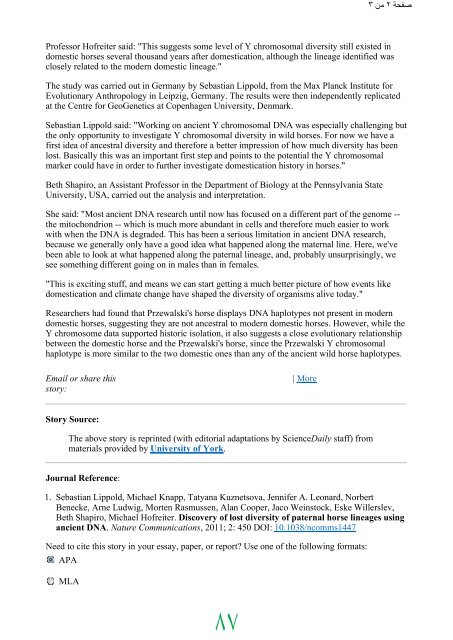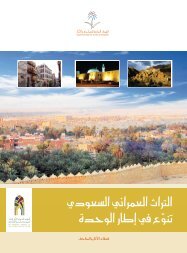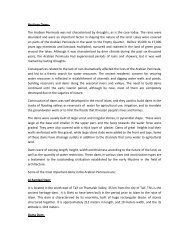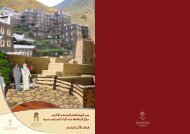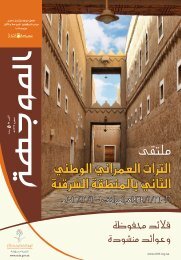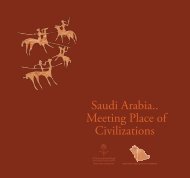ﺧïºØ¯Ù اï»ïº¤ïº®ï»£ï¯¿ï»¦
ﺧïºØ¯Ù اï»ïº¤ïº®ï»£ï¯¿ï»¦
ﺧïºØ¯Ù اï»ïº¤ïº®ï»£ï¯¿ï»¦
You also want an ePaper? Increase the reach of your titles
YUMPU automatically turns print PDFs into web optimized ePapers that Google loves.
87<br />
http://www.sciencedaily.com/releases/2011/08/110823115145.htm<br />
صفحة ٢ من ٣<br />
٣٢/٠٩/٢٧<br />
Professor Hofreiter said: "This suggests some level of Y chromosomal diversity still existed in<br />
domestic horses several thousand years after domestication, although the lineage identified was<br />
closely related to the modern domestic lineage."<br />
The study was carried out in Germany by Sebastian Lippold, from the Max Planck Institute for<br />
Evolutionary Anthropology in Leipzig, Germany. The results were then independently replicated<br />
at the Centre for GeoGenetics at Copenhagen University, Denmark.<br />
Sebastian Lippold said: "Working on ancient Y chromosomal DNA was especially challenging but<br />
the only opportunity to investigate Y chromosomal diversity in wild horses. For now we have a<br />
first idea of ancestral diversity and therefore a better impression of how much diversity has been<br />
lost. Basically this was an important first step and points to the potential the Y chromosomal<br />
marker could have in order to further investigate domestication history in horses."<br />
Beth Shapiro, an Assistant Professor in the Department of Biology at the Pennsylvania State<br />
University, USA, carried out the analysis and interpretation.<br />
She said: "Most ancient DNA research until now has focused on a different part of the genome --<br />
the mitochondrion -- which is much more abundant in cells and therefore much easier to work<br />
with when the DNA is degraded. This has been a serious limitation in ancient DNA research,<br />
because we generally only have a good idea what happened along the maternal line. Here, we've<br />
been able to look at what happened along the paternal lineage, and, probably unsurprisingly, we<br />
see something different going on in males than in females.<br />
"This is exciting stuff, and means we can start getting a much better picture of how events like<br />
domestication and climate change have shaped the diversity of organisms alive today."<br />
Researchers had found that Przewalski's horse displays DNA haplotypes not present in modern<br />
domestic horses, suggesting they are not ancestral to modern domestic horses. However, while the<br />
Y chromosome data supported historic isolation, it also suggests a close evolutionary relationship<br />
between the domestic horse and the Przewalski's horse, since the Przewalski Y chromosomal<br />
haplotype is more similar to the two domestic ones than any of the ancient wild horse haplotypes.<br />
Email or share this<br />
story:<br />
| More<br />
Story Source:<br />
The above story is reprinted (with editorial adaptations by ScienceDaily staff) from<br />
materials provided by University of York.<br />
Journal Reference:<br />
1.<br />
Sebastian Lippold, Michael Knapp, Tatyana Kuznetsova, Jennifer A. Leonard, Norbert<br />
Benecke, Arne Ludwig, Morten Rasmussen, Alan Cooper, Jaco Weinstock, Eske Willerslev,<br />
Beth Shapiro, Michael Hofreiter. Discovery of lost diversity of paternal horse lineages using<br />
ancient DNA. Nature Communications, 2011; 2: 450 DOI: 10.1038/ncomms1447<br />
Need to cite this story in your essay, paper, or report? Use one of the following formats:<br />
APA<br />
MLA


